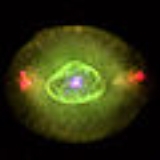
NGC 6826
Encyclopedia
NGC 6826 is a planetary nebula located in the constellation
Cygnus
. It is commonly referred to as the "blinking planetary", although many other nebulae exhibit such "blinking". When viewed through a small telescope, the brightness of the central star overwhelms the eye when viewed directly, obscuring the surrounding nebula. However, it can be viewed well in the peripheral vision (averted vision
), which causes it to "blink" in and out of view as the observer's eye wanders.
A distinctive feature of this nebula are the two bright patches on either side, which are known as FLIERs
, or Fast Low-Ionization Emission Regions. They appear to be relatively young, moving outwards at supersonic speeds. According to Bruce Balick (University of Washington), "some of their observed characteristics suggest that they are like sparks flung outward from the central star late in the very recent past (a thousand years ago). Yet their shapes ... seem to suggest that they are stationary, and that material ejected from the star flows past them, scraping gas from their surfaces. Future Hubble observations will monitor any changes in the positions of FLIERs to resolve this issue. In either case, the formation of FLIERs cannot be easily explained by any models of stellar evolution."
Constellation
In modern astronomy, a constellation is an internationally defined area of the celestial sphere. These areas are grouped around asterisms, patterns formed by prominent stars within apparent proximity to one another on Earth's night sky....
Cygnus
Cygnus (constellation)
Cygnus is a northern constellation lying on the plane of the Milky Way. Its name is the Latinized Hellenic word for swan. One of the most recognizable constellations of the northern summer and autumn, it features a prominent asterism known as the Northern Cross...
. It is commonly referred to as the "blinking planetary", although many other nebulae exhibit such "blinking". When viewed through a small telescope, the brightness of the central star overwhelms the eye when viewed directly, obscuring the surrounding nebula. However, it can be viewed well in the peripheral vision (averted vision
Averted vision
Averted vision is a technique for viewing faint objects which uses peripheral vision. It involves not looking directly at the object, but looking a little off to the side, while continuing to concentrate on the object. This subject is discussed in the popular astronomy literature but only a few...
), which causes it to "blink" in and out of view as the observer's eye wanders.
A distinctive feature of this nebula are the two bright patches on either side, which are known as FLIERs
Fast Low-Ionization Emission Region
Fast Low-Ionization Emission Region, or FLIER, is the name for volumes of gas with low ionization near the symmetry axis of many planetary nebulae. Red in color, they and bolt out from planetary nebulae, clouds of ejected material from sunlike, old stars in the process of dying and exploding, at...
, or Fast Low-Ionization Emission Regions. They appear to be relatively young, moving outwards at supersonic speeds. According to Bruce Balick (University of Washington), "some of their observed characteristics suggest that they are like sparks flung outward from the central star late in the very recent past (a thousand years ago). Yet their shapes ... seem to suggest that they are stationary, and that material ejected from the star flows past them, scraping gas from their surfaces. Future Hubble observations will monitor any changes in the positions of FLIERs to resolve this issue. In either case, the formation of FLIERs cannot be easily explained by any models of stellar evolution."
External links
- The Hubble European Space Agency Information Centre Hubble picture and information on NGC 6826

